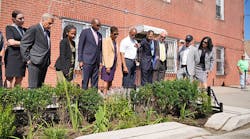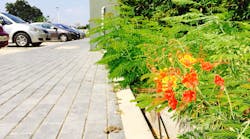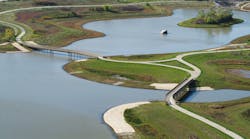NEWARK, DE, Apr. 10, 2012 -- This week, U.S. Senator Tom Carper, DNREC Secretary Collin O'Mara and members of the media got a look at how engineering students will swelter a lot less in the University of Delaware's Colburn Laboratory classrooms, thanks to grant funding and some unique engineering by the school's landscape design program to create an environmentally-friendly green roof.
"This new green roof project at the University of Delaware is a great example of the power of public-private partnerships," said Senator Carper (D-Del.). "With support from the state of Delaware, the Dupont Company, and the University of Delaware, this project is helping to lower energy use, clean the air and teach sustainable environmental practices to future generations at the same time."
About 600 engineering students take classes in the Colburn Lab's 1960s one-story classroom wing, where indoor temperatures have been known to reach 86 degrees due to heat transfer from its southern exposure, wide expanses of glass and flat roof. Installing reduced wattage lights, ventilation maintenance and other measures failed to reduce temperatures to levels low enough for learning.
Among the chronically overheated were Dr. Annette Shine, associate professor of chemical engineering, and her teaching assistant, Kathy Phillips, who thought a green roof might make a cost-effective and environmentally-friendly difference. They connected with Chad Nelson, assistant professor of landscape design, and student Aaron Hallett, who were interested in starting a green roof project on campus.
The resulting green roof plan offers a variety of environmental, educational and fiscal benefits:
• A sponge effect, absorbing stormwater runoff to improve water quality in nearby waterways;
• A teaching tool, allowing engineering students to study "green engineering" solutions in a living classroom;
• An insulating effect, with 4 inch-deep plantings reducing the temperature of the roof and keeping the classrooms and occupants below cooler by six degrees or more;
• Reduction of carbon dioxide emissions by reducing demand on building HVAC systems;
• An opportunity for students to get hands-on experience in growing the plants and installing the system;
• A less costly option than replacing the building's HVAC, reduced energy costs from operating the existing system with less demand -- and a more attractive view from the three-story portion of the building overlooking the roof.
"Once again the University is demonstrating how environmental innovations can address the interrelated challenges of improving air quality, reducing energy consumption, managing stormwater effectively, and reducing operating expenses," Secretary O'Mara said. "This green roof will save UD thousands of dollars, while providing significant educational opportunities and environmental benefits for years to come."
Built in the 1960s, the one-story building had been originally designed to have additional stories added later, so an initial study found the existing roof structure could support the additional weight. With that key question answered, the project moved forward, with total costs estimated at $60,000. The project received a Regional Greenhouse Gas Initiative (RGGI) program grant, administered by the DNREC Division of Energy and Climate, plus a grant from the DuPont Clear into the Future program for environmentally-beneficial projects and grants from two UD programs, the University of Delaware Energy Institute and the University of Delaware Sustainability Fund.
Instead of using a membrane system that would cover the whole roof, Nelson opted for a more flexible modular system consisting of 2-foot by 2-foot plastic trays that could be installed by students and volunteers and moved for roof maintenance. A safety railing was installed around the roof edge, along with a locking door for roof access.
Beginning last spring, students from the University's College of Agriculture propagated heat-hardy plants including several varieties of colorful sedum, plus chives and crocus. Next, the students established them in the trays with help from local Girl Scouts and began moving them to the roof into a pattern that echoes the layout of the building below.
"The system now covers more than a quarter of the roof area, about 1,200 square feet," Nelson said of the ongoing work. "Our goal is to have more than half covered by June, towards a final total of about 2,600 square feet. The remainder of the roof will be recycled rubber tile access paths and allowances around the perimeter and mechanical equipment."
"The Colburn Lab green roof exemplifies what happens when several groups work together and follow through on a good idea," added Robin W. Morgan, Dean of the University's College of Agriculture and Natural Resources. "Simple in design and big in impact, these useful and beautiful plantings are a great addition to Colburn Lab."
A cooperative effort between nine states including Delaware, the Regional Greenhouse Gas Initiative (RGGI) is the first market-based regulatory program in the United States to reduce greenhouse gas emissions. States sell nearly all emission allowances through auctions and invest proceeds in consumer benefits: energy efficiency, renewable energy, and other clean energy technologies. RGGI is spurring innovation in the clean energy economy and creating green jobs in each state. Funding for Delaware's RGGI grant program comes from 10 percent of Delaware's emissions auction proceeds.
###


